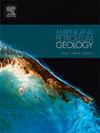墨西哥西北部下侏罗统 Sierra de Santa Rosa 地层中三叠统和侏罗统弧岩浆活动的影响:地球化学和铀-铅地质年代的制约因素
IF 3.7
2区 地球科学
Q1 GEOSCIENCES, MULTIDISCIPLINARY
引用次数: 0
摘要
墨西哥索诺拉北部 El Antimonio 组的二叠三叠世和下侏罗世沉积演替被推断为沉积于弧前盆地,其年龄已通过化石组合和锆英石地质年代学得到证实。在这项研究中,对位于 Sierra del Álamo 地区的 El Antimonio 组较年轻的单元 Sierra de Santa Rosa 地层进行了岩石学、地球化学和非晶锆石 U-Pb 地质年代学研究,以确定其构造环境、年龄、源区古风化和产地。Sierra de Santa Rosa地层的砂岩在岩石学上被归类为箭砂岩。元素比率、REE模式和Eu异常以及二元和三元图表明,Sierra de Santa Rosa地层的碎屑来源于火成岩长岩,在干旱气候条件下受到弱到中度的化学风化。该单元七个砂岩样本的碎屑锆石 U-Pb 地球年代学记录了新生代年龄的主要族群(占总颗粒的 58%),年龄峰值为 1.68、1.39 和 1.14 Ga。1.39 Ga 和 1.14 Ga 以及三叠纪(占样品总数的 31%)(年龄峰值为 219 Ma),其次是古生代、侏罗纪和奥陶纪。锆石颗粒的主要来源是区域附近的火成变质原生代基底岩石、原生代和古生代沉积覆盖层的回收碎屑以及北美西南部的二叠三叠纪和侏罗纪大陆岩浆弧。根据年代样本的锆英石U-Pb地质年代,可以确定阿兰莫山脉地区圣罗莎山脉地层的新元古代至托尔干早期的最大沉积年龄。本文章由计算机程序翻译,如有差异,请以英文原文为准。
Influence of Triassic and Jurassic arc magmatism in Lower Jurassic Sierra de Santa Rosa Formation, northwestern México: Constraints from geochemistry and U-Pb geochronology
The Permo-Triassic and Lower Jurassic sedimentary succession of the El Antimonio Group in northern Sonora, Mexico is inferred to be deposited in a forearc basin and its age has been constrained by fossil assemblages and detrital zircon geochronology. In this work, petrography, geochemistry and detrital zircon U-Pb geochronology were undertaken on the Sierra de Santa Rosa Formation, the younger unit of the El Antimonio Group in the locality of the Sierra del Álamo, to constrain its tectonic setting, age, source area paleoweathering, and provenance. Sandstone of Sierra de Santa Rosa Formation is petrographically classified as arkose. The elemental ratios, REE patterns and Eu anomaly, as well as bivariate and ternary plots suggest igneous felsic sources subjected to weak to moderated chemical weathering under arid climatic conditions for detritus of the Sierra de Santa Rosa Formation. Detrital zircon U-Pb geochronology of seven sandstone samples of this unit record main populations of Proterozoic age (58% of the total grains) with age peaks at 1.68. 1.39 and 1.14 Ga and Triassic age (31% of total grains) with age peak at 219 Ma, and subordinate groups of Paleozoic, Jurassic and Archean ages. Main sources for the zircon grains are the regional nearby igneous-metamorphic Proterozoic basement rocks, recycled detritus from the Proterozoic and Paleozoic sedimentary cover, and the Permo-Triassic and Jurassic continental magmatic arcs of southwestern North America. The detrital zircon U-Pb geochronology of the dated samples allows to establish Sinemurian to early Toarcian maximum depositional ages for the Sierra de Santa Rosa Formation in the locality of the Sierra del Álamo.
求助全文
通过发布文献求助,成功后即可免费获取论文全文。
去求助
来源期刊

Marine and Petroleum Geology
地学-地球科学综合
CiteScore
8.80
自引率
14.30%
发文量
475
审稿时长
63 days
期刊介绍:
Marine and Petroleum Geology is the pre-eminent international forum for the exchange of multidisciplinary concepts, interpretations and techniques for all concerned with marine and petroleum geology in industry, government and academia. Rapid bimonthly publication allows early communications of papers or short communications to the geoscience community.
Marine and Petroleum Geology is essential reading for geologists, geophysicists and explorationists in industry, government and academia working in the following areas: marine geology; basin analysis and evaluation; organic geochemistry; reserve/resource estimation; seismic stratigraphy; thermal models of basic evolution; sedimentary geology; continental margins; geophysical interpretation; structural geology/tectonics; formation evaluation techniques; well logging.
 求助内容:
求助内容: 应助结果提醒方式:
应助结果提醒方式:


